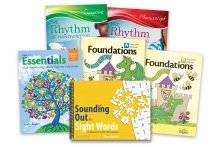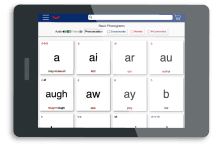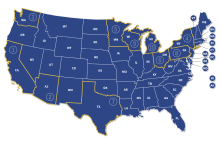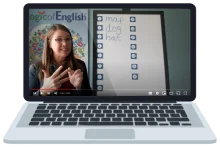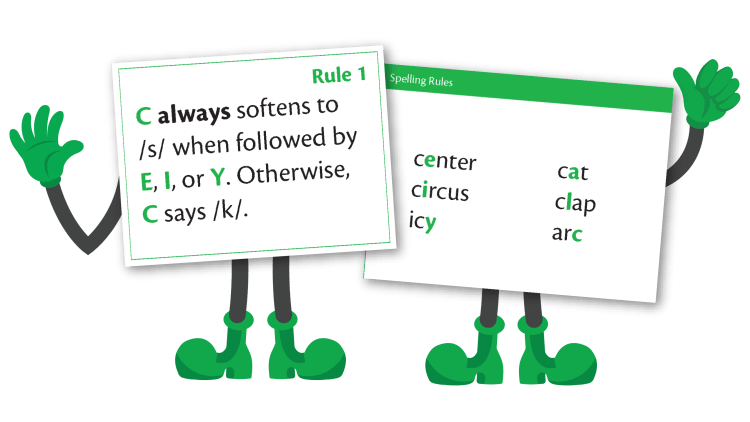Rule 1: C always softens to /s/ when followed by E, I, or Y. Otherwise, C says /k/.
Rule 2: G may soften to /j/ only when followed by E, I, or Y. Otherwise, G says /g/.
Rule 3: English words do not end in I, U, V, or J.
Rule 4: A E O U usually say their long sounds at the end of the syllable.
Rule 5: I and Y may say /ĭ/ or /ī/ at the end of a syllable.
Rule 6: When a one-syllable word ends in a single-vowel Y, it always says /ī/.
Rule 7: Where I and Y may say long /ē/:
- 7.1: Y says /ē/ only in an unstressed syllable at the end of a multi-syllable word.
- 7.2: I may say /ē/ with a silent final E, at the end of a syllable, and at the end of foreign words.
Rule 8: I and O may say /ī/ and /ō/ when followed by two consonants.
Rule 9: AY usually spells the sound /ā/ at the end of a base word.
Rule 10: When a word ends with the phonogram A, it says /ä/. A may also say /ä/ after a W or before an L.
Rule 11: Q always needs a U; therefore, U is not a vowel here.
Rule 12: Silent Final E Rules:
- 12.1: The vowel says its long sound because of the E.
- 12.2: English words do not end in V or U.
- 12.3: The C says /s/ and the G says /j/ because of the E.
- 12.4: Every syllable must have a written vowel.
- 12.5: Add an E to keep singular words that end in the letter S from looking plural.
- 12.6: Add an E to make the word look bigger.
- 12.7: TH says its voiced sound /TH/ because of the E.
- 12.8: Add an E to clarify meaning.
- 12.9: Unseen reason.
Rule 13: Drop the silent final E when adding a vowel suffix only if it is allowed by other spelling rules.
Rule 14: Double the last consonant when adding a vowel suffix to words ending in one vowel followed by one consonant only if the syllable before the suffix is stressed.*
*This is always true for one-syllable words.
Rule 15: Single-vowel Y changes to I when adding any ending, unless the ending begins with I.
Rule 16: Two I’s cannot be next to one another in English words.
Rule 17: TI, CI, and SI are used only at the beginning of any syllable after the first one.
Rule 18: SH spells /sh/ at the beginning of a base word and at the end of the syllable. SH never spells /sh/ at the beginning of any syllable after the first one, except for the ending -ship.
Rule 19 To make a verb past tense, add the ending -ED unless it is an irregular verb.
Rule 20: -ED, past tense ending, forms another syllable when the base word ends in /d/ or /t/. Otherwise, -ED says /d/ or /t/.
Rule 21: To make a noun plural, add the ending -S, unless the word hisses or changes; then add -ES. Some nouns have no change or an irregular spelling.
Rule 22: To make a verb 3rd person singular, add the ending -S, unless the word hisses or changes; then add -ES. Only four verbs are irregular. (has, does, goes, is)
Rule 23: AL- is a prefix written with one L when preceding another syllable.
Rule 24: -FUL is a suffix written with one L when added to another syllable.
Rule 25: DGE is used only after a single vowel which says its short (first) sound.
Rule 26: CK is used only after a single vowel which says its short (first) sound.
Rule 27: TCH is used only after a single vowel which says its short or broad sound.
Rule 28: AUGH, EIGH, IGH, OUGH. Phonograms ending in GH are used only at the end of a base word or before the letter T. The GH is either silent or pronounced /f/.
Rule 29: Z, never S, spells /z/ at the beginning of a base word.
Rule 30: We often double F, L, and S after a single, short or broad vowel at the end of a base word. Occasionally other letters also are doubled.
Rule 31: Schwa Rules
- 31.1: Any vowel may say one of the schwa sounds, /ŭ/ or /ĭ/, in an unstressed syllable or unstressed word.
- 31.2: O may say /ŭ/ in a stressed syllable next to W, TH, M, N, or V.
- 31.3: AR and OR may say their schwa sound, /er/, in an unstressed syllable.

